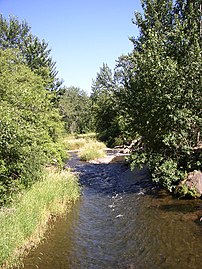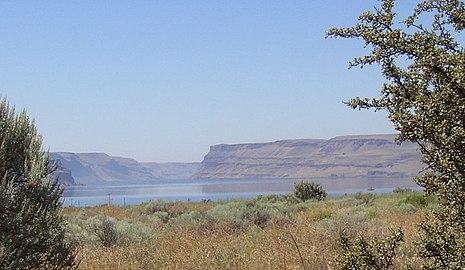Walla Walla River
| Walla Walla River | |
|---|---|
 Confluence of the Walla Walla and the Columbia rivers. | |
| Location | |
| Country | United States |
| State | Washington |
| Physical characteristics | |
| Source | Blue Mountains |
| • location | nearMilton–Freewater |
| • coordinates | 45°53′54″N118°18′28″W/ 45.89833°N 118.30778°W[1] |
| Mouth | Columbia RiveratLake Wallula |
• location | Wallula |
• coordinates | 46°3′58″N118°55′3″W/ 46.06611°N 118.91750°W[1] |
| Length | 61 mi (98 km) |
| Basin size | 1,758 sq mi (4,550 km2)[2] |
| Discharge | |
| • location | Walla Walla |
| • average | 589 cu ft/s (16.7 m3/s)[3] |
| • maximum | 33,400 cu ft/s (950 m3/s)[3] |
TheWalla Walla Riveris a tributary of theColumbia River,joining the Columbia just aboveWallula Gapin southeasternWashingtonin the United States. The river flows throughUmatilla County, Oregon,andWalla Walla County, Washington.[1]Itsdrainage basinis 1,758 square miles (4,550 km2) in area.[2]
Course
[edit]The headwaters of the Walla Walla River lie in theBlue Mountainsof northeasternOregon.The river originates as the North and South Forks of the Walla Walla River. The surrounding forested land holds a network of hiking and mountain-biking trails.
The confluence of the North and South Forks lies east ofMilton–Freewater,Oregon. The river flows eastward to reach Milton–Freewater, which is built along its banks, and then flows northward through Milton–Freewater. Irrigation water is drawn from the river here and at numerous locations along the river.
The Walla Walla River flows southwest of the city ofWalla Wallain the Walla Walla valley.Mill Creek,which flows through the city of Walla Walla, joins the Walla Walla River at theWhitman Missionwest of the city of Walla Walla.
TheTouchet Riverjoins the Walla Walla at the town ofTouchet, Washington.The annual meandischargeof the Walla Walla River just below the Touchet River confluence is 589 cu ft/s (16.7 m3/s). The maximum recorded discharge was 33,400 cu ft/s (950 m3/s) in 1964.[3][4]
The river enters the Columbia a mile south of the town ofWallulajust north ofWallula Gap.The section of the Columbia River is called Wallula Lake, the reservoir impoundment created byMcNary Dam.
History
[edit]
TheWalla Walla tribeoccupied the region around the Walla Walla river prior to white settlers entry to the region.
TheLewis and Clark Expedition(1804–1806) was the firstUnited Statesoverland expedition to the Pacific coast and back—the return expedition stopped at the mouth of the Walla Walla and stayed with the Walla Walla tribe for a portion of the journey, proceeding from there overland to theSnake River.British explorerDavid Thompsonwas the first European to navigate the entire length of the Columbia River, to the Pacific Ocean, in 1811.
Fort Nez Percés(later known asFort Walla Walla) was a fortifiedfur tradingpost on theColumbia Riveron the territory of modern-day Wallula, Washington. It was in operation from 1818 until 1857 on the eastern shore of the Columbia River, immediately north of the mouth of the Walla Walla River. TheOregon Treatyended joint U.S.A. - British occupation that had been effect since theTreaty of 1818.The fort was abandoned in 1857 when theHudson's Bay Companygave up itsColumbia Districtbusiness in theOregon Territory.
TheWhitman Missionwas established in 1836. It lies near the banks of the river to the west of the modern city of Walla Walla.
Fish
[edit]The Walla Walla River supports populations of springChinook salmon,summersteelhead,andbull troutamong other species. There is a sport fishery for steelhead in the river. It also holdschannel catfishandsmallmouth bassin the summer.
Science
[edit]Work done by Oregon and Washington State governments, federal and state environmental agencies and local watershed councils and groups on the Walla Walla River & the overall catchment area has produced a wide range of studies. The Walla Walla Basin Watershed Council (WWBWC www.wwbwc.org) has both electronic and paper copies of many of these reports that date back to the 1930s. Considerable work has gone into the assessment of water quantity and quality for the purpose of salmon recovery and sustainable irrigation supply. A highly-connected alluvial groundwater system and its over-abstraction through over-allocated irrigation usage have also acted to influence flows and quality in the Walla Walla River.
The promise of the Walla Walla River lies in its integrated water-management strategy using Managed Aquifer Recharge (Or Shallow Aquifer Recharge) to utilise available non-irrigation season water to replenish groundwater supplies and the over-allocation of groundwater resources by both state governments. The Walla Walla partnership along with the WWBWC set a national example with this innovative and low-cost alternative to surface storage using dams.
Photos
[edit]-
The South Fork of the Walla Walla River at Harris Park, 13 miles (21 km) above Milton-Freewater, Oregon
-
The North Fork of the Walla Walla River above Milton-Freewater
-
The Wallula Gap, where the Walla Walla enters the Columbia, as seen from nearFort Nez Percés,looking to the south
-
South Fork of Walla Walla River at Harris Park, Umatilla County, Oregon
-
Walla Walla River in theBlue Mountainsof northeastern Oregon
See also
[edit]- List of rivers of Oregon
- List of longest streams of Oregon
- List of tributaries of the Columbia River
- List of Washington rivers
- Walla Walla Basin Watershed Council
References
[edit]- ^abcU.S. Geological Survey Geographic Names Information System: Walla Walla River
- ^abWalla Walla Subbasin PlanArchived2012-02-13 at theWayback Machine,Northwest Power and Conservation Council
- ^abc"USGS National Water Information System: Web Interface".USGS.Retrieved28 February2024.
- ^Water Resources Data, Washington Water year 2005,USGS Water-Data Reports
External links
[edit]- Flows and Forecasts on the Walla Walla RiverArchived2016-03-04 at theWayback Machine






